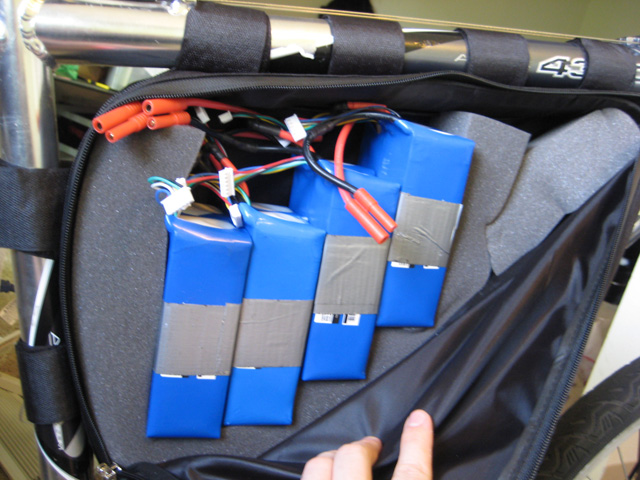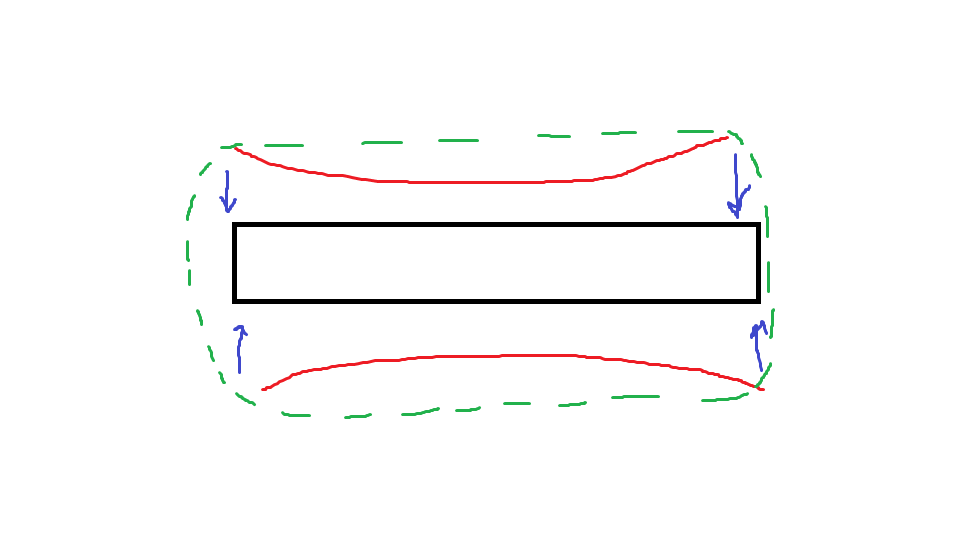acuteaero
100 W
At the end of March earlier this year I put together six 6s packs of Kokam HP 16AH cells in preparation for the race at the Grange racetrack in early April. I have been riding around with three of these packs on my bicycle "the shortbus", with a Clyte HS motor in 17" moped wheel. Photos and a description of the pack construction technique I used can be found at this post here http://endless-sphere.com/forums/viewtopic.php?f=14&t=38761#p565974 and on Picasa: https://picasaweb.google.com/106371422363746314682/DK16AHBuild?authuser=0&feat=directlink
That's the background to this story- I've put several hundred miles of riding on the bike and the packs have been good. I haven't needed to balance them at all, they have stayed in very good balance. I have not however pushed their upper or lower limits, I have only gone to maybe 75% DOD. On Friday after work I went to a local park and rode around on the bicycle trails- rode 15 miles on dirt/rock. The trail is very rutted and rocky, the suspension fork on the bike did very well, but it's a hardtail so it bounced around pretty hard.
When I got back home I inspected the batteries by removing each 6s group of cells from their cor-plast box- to my dismay I found quite a lot of physical damage caused by the impacts due to the freedom of the packs to move in their holders, and the lack of compliant padding- one cell in one group was damaged to the point of leaking electrolyte from the bottom of the cell. I immediately unbuilt the pack and moved that cell to a metal box on my concrete driveway, I will figure out what to do with it later. Here are the pictures I took of the disassembly process.
Here's the full set of pictures, on picasa: https://picasaweb.google.com/106371...authkey=Gv1sRgCLuZ2ZKyvde7mQE&feat=directlink
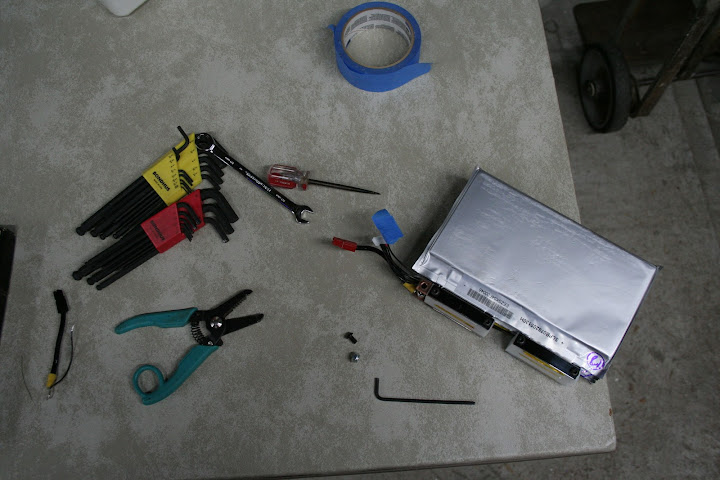
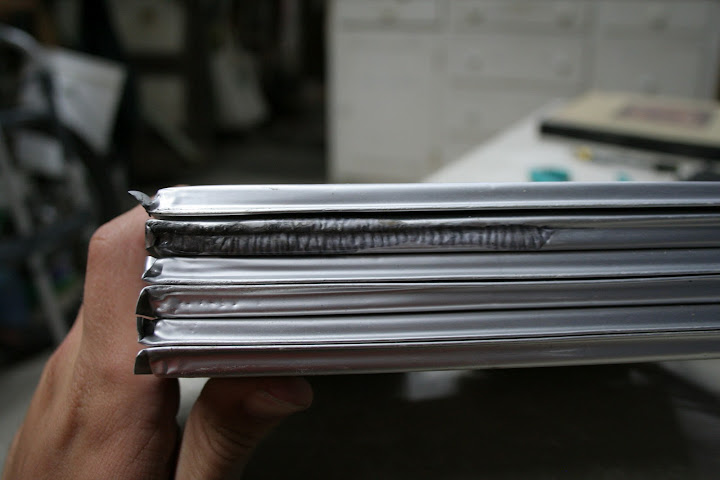

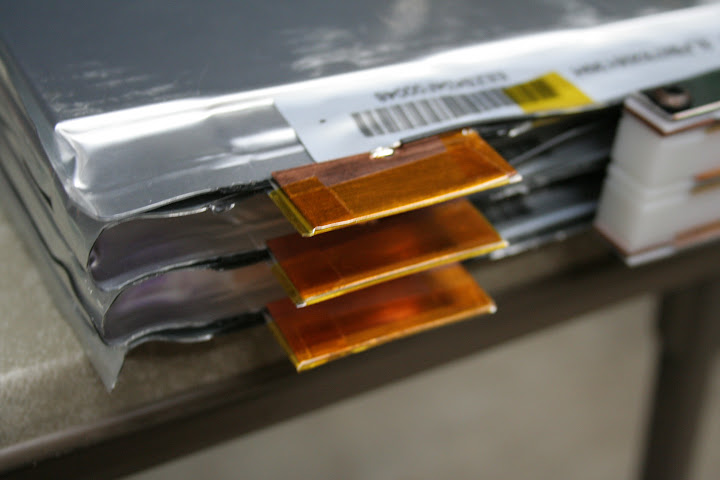
The damaged cell is on the left, good cell is on the right. The bad cell has enough gas/air inside so that the bag hangs loosely around the contents. Suppose you would call it 'puffed'. The two strips of "wall saver" double sided tape are visible here.

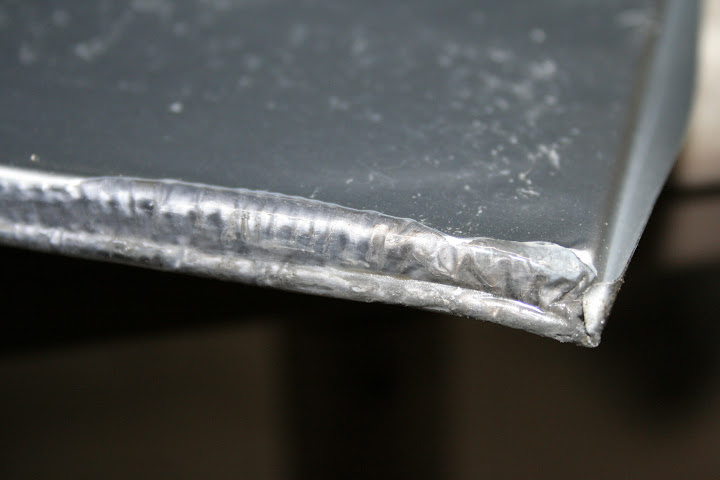
I don't really expect the cell to spontaneously burn but I feel better with it in this box outside on the driveway rather than inside while I'm at work during the day.
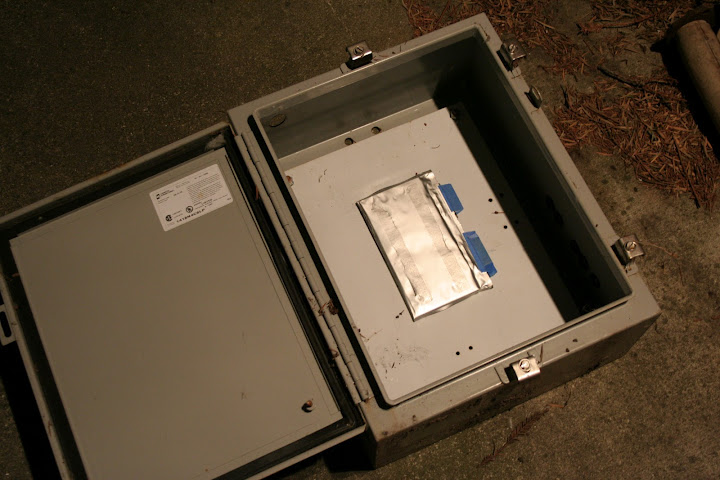
This incident makes me feel a bit stupid and noobish, and maybe all the armchair engineers out there can point out how obviously I set myself up to fail here- but I figured I'd post these pictures to make a record of "what happens when this particular stupid thing is tried", and to elicit constructive feedback beyond the conclusions I make about it (hopefully )
)
In using, and unbuilding the packs- some things about my construction and mounting method that do seem to have worked out well, as seen in the build post linked above, and in the above photos.:
Obviously there are issues- some visible some less so in the photos. Here are a couple photos of how the packs go on the bike as well:
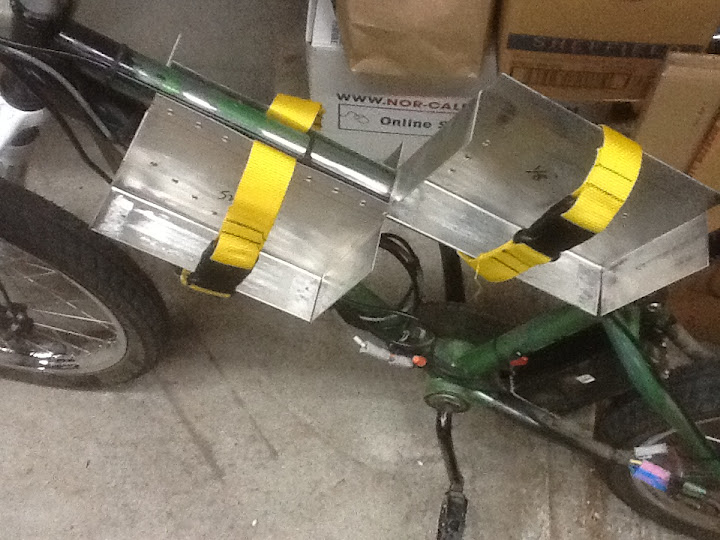
Note the wear on the surface of the aluminum sheet that makes up the bracket. This area is quite rough to the touch as well.
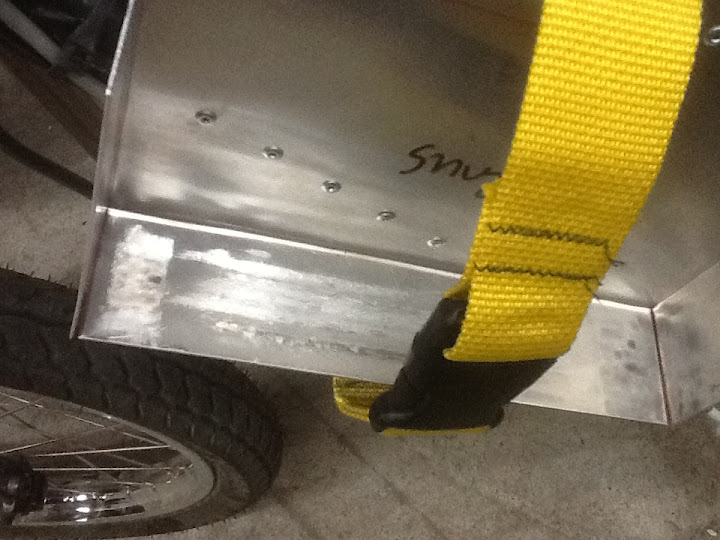
Obviously, the packs are moving too much, and there is not enough compliant support to cushion the cells from impact when they are moving.
I was curious to see what had happened to the corplast under the cells- had it been smashed and collapsed? So I sectioned a box with a box cutter.
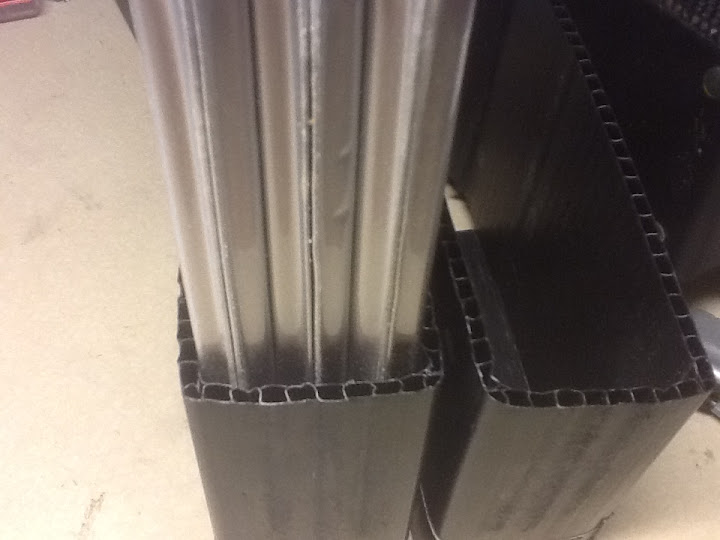
Looks like the corplast has not collapsed at all, that in fact it has behaved as a rigid hard body against the cells and provided very little to no cushioning action at all.
Some other issues with the packs: Dirt and other junk tends to get into the corplast box, and then with the movement of the cells inside the corplast the junk scrapes, scratches and pits the soft sides of the cells.
So, what do I learn from this, and what direction do I go in the future to prevent this from happening again? I think there's two routes here- either prevent movement of the cells at all, rigidly mount them inside the protective case- or mount them less rigidly with plenty of padding to prevent damage from forces due to acceleration. I think preventing movement of the cells is the better way to do it- it's possible that just a piece of stiff foam under the yellow strap to put pressure downward on the pack into the bracket would have greatly reduced the severity of the problem and maybe even prevented the failure that occurred. I think there are better ways of doing it though.
I imagine that it would probably be good to prevent motion of the cells inside the box. The corplast boxes are a pretty sung fit around the cell, but there is obviously plenty of movement going on, as I can see from the wear on the cells and box, and the scratching from foreign matter floating inside the box. This movement could be prevented by clamping force, by rigid end plates and straps or bolts to create tension- or likely more compact to double sided tape the cells inside the box (hurts serviceability though...)
Doing a little simple searching, this is a matter that has been covered before-
http://endless-sphere.com/forums/viewtopic.php?f=14&t=17497&start=15
http://endless-sphere.com/forums/viewtopic.php?f=14&t=15408&start=210
Sounds like double sided tape is a good approach for this problem- as I noted, it's worked great between the cells.
I think I will fabricate tougher, stiffer boxes than the corplast boxes, and double sided tape the cells into them, then make a more secure and tighter mount on the bike.
Sorry for the somewhat rambling post. Working with raw pouch cells (which more and more people are doing these days) is a blessing (energy/power dense) and a curse (lots of factors to consider for long term reliability!)
That's the background to this story- I've put several hundred miles of riding on the bike and the packs have been good. I haven't needed to balance them at all, they have stayed in very good balance. I have not however pushed their upper or lower limits, I have only gone to maybe 75% DOD. On Friday after work I went to a local park and rode around on the bicycle trails- rode 15 miles on dirt/rock. The trail is very rutted and rocky, the suspension fork on the bike did very well, but it's a hardtail so it bounced around pretty hard.
When I got back home I inspected the batteries by removing each 6s group of cells from their cor-plast box- to my dismay I found quite a lot of physical damage caused by the impacts due to the freedom of the packs to move in their holders, and the lack of compliant padding- one cell in one group was damaged to the point of leaking electrolyte from the bottom of the cell. I immediately unbuilt the pack and moved that cell to a metal box on my concrete driveway, I will figure out what to do with it later. Here are the pictures I took of the disassembly process.
Here's the full set of pictures, on picasa: https://picasaweb.google.com/106371...authkey=Gv1sRgCLuZ2ZKyvde7mQE&feat=directlink
The damaged cell is on the left, good cell is on the right. The bad cell has enough gas/air inside so that the bag hangs loosely around the contents. Suppose you would call it 'puffed'. The two strips of "wall saver" double sided tape are visible here.
I don't really expect the cell to spontaneously burn but I feel better with it in this box outside on the driveway rather than inside while I'm at work during the day.
This incident makes me feel a bit stupid and noobish, and maybe all the armchair engineers out there can point out how obviously I set myself up to fail here- but I figured I'd post these pictures to make a record of "what happens when this particular stupid thing is tried", and to elicit constructive feedback beyond the conclusions I make about it (hopefully
In using, and unbuilding the packs- some things about my construction and mounting method that do seem to have worked out well, as seen in the build post linked above, and in the above photos.:
- The clampy-bars that electrically connect the cells and provide main positive and negative, and balance wires seem to work just fine, there was no visible degradation of anything and they've been functioning just fine. (However, I think they were too labor intensive and I would do it differently if I were to redo it.)
- The scotch brand "wallsaver" did a good job,it's thin enough and it was easy enough to remove with a spatula between the cells when it came time to unbuild the pack.
- The mounting system has been convenient, allowing me to mount and remove the batteries from the bike in very little time when I put the bike in my car, etc.
Obviously there are issues- some visible some less so in the photos. Here are a couple photos of how the packs go on the bike as well:
Note the wear on the surface of the aluminum sheet that makes up the bracket. This area is quite rough to the touch as well.
Obviously, the packs are moving too much, and there is not enough compliant support to cushion the cells from impact when they are moving.
I was curious to see what had happened to the corplast under the cells- had it been smashed and collapsed? So I sectioned a box with a box cutter.
Looks like the corplast has not collapsed at all, that in fact it has behaved as a rigid hard body against the cells and provided very little to no cushioning action at all.
Some other issues with the packs: Dirt and other junk tends to get into the corplast box, and then with the movement of the cells inside the corplast the junk scrapes, scratches and pits the soft sides of the cells.
So, what do I learn from this, and what direction do I go in the future to prevent this from happening again? I think there's two routes here- either prevent movement of the cells at all, rigidly mount them inside the protective case- or mount them less rigidly with plenty of padding to prevent damage from forces due to acceleration. I think preventing movement of the cells is the better way to do it- it's possible that just a piece of stiff foam under the yellow strap to put pressure downward on the pack into the bracket would have greatly reduced the severity of the problem and maybe even prevented the failure that occurred. I think there are better ways of doing it though.
I imagine that it would probably be good to prevent motion of the cells inside the box. The corplast boxes are a pretty sung fit around the cell, but there is obviously plenty of movement going on, as I can see from the wear on the cells and box, and the scratching from foreign matter floating inside the box. This movement could be prevented by clamping force, by rigid end plates and straps or bolts to create tension- or likely more compact to double sided tape the cells inside the box (hurts serviceability though...)
Doing a little simple searching, this is a matter that has been covered before-
http://endless-sphere.com/forums/viewtopic.php?f=14&t=17497&start=15
http://endless-sphere.com/forums/viewtopic.php?f=14&t=15408&start=210
Sounds like double sided tape is a good approach for this problem- as I noted, it's worked great between the cells.
I think I will fabricate tougher, stiffer boxes than the corplast boxes, and double sided tape the cells into them, then make a more secure and tighter mount on the bike.
Sorry for the somewhat rambling post. Working with raw pouch cells (which more and more people are doing these days) is a blessing (energy/power dense) and a curse (lots of factors to consider for long term reliability!)


